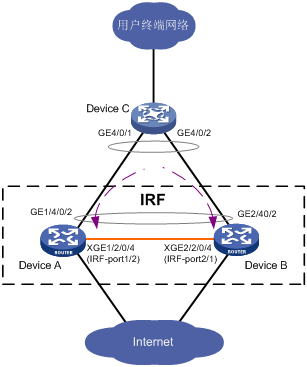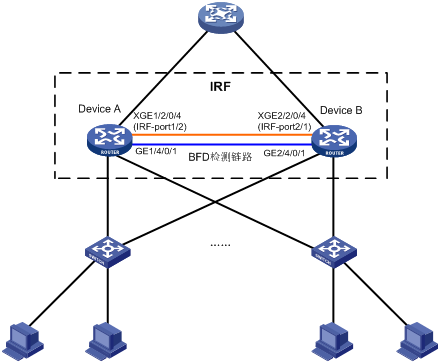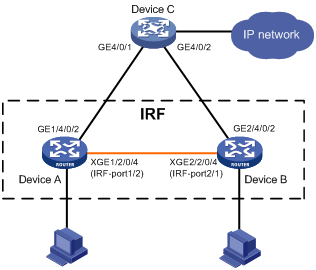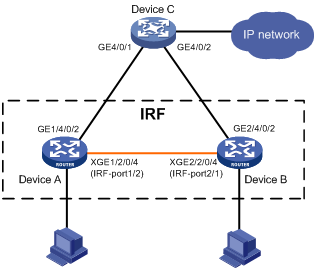irf配置
- 1关注
- 2收藏,3000浏览
问题描述:
两台路由器做堆叠,可以使用多个接口做堆叠口吗,防止一个接口故障,导致irf分裂,如何可以麻烦告诉具体配置
组网及组网描述:
- 2020-08-03提问
- 举报
-
(0)
最佳答案

可以的,单根和多跟的话把多条线键入到堆叠口即可
3.12 IRF典型配置举例
3.12.1 IRF典型配置举例(LACP MAD检测方式)
1. 组网需求
为提高网络出口可靠性,使用Device A、Device B做为内网出口设备,为便于对设备Device A与Device B易管理、易维护。使用IRF技术,并使用LACP MAD功能及时发现和处理IRF的分裂事件。
2. 组网图
图3-13 IRF典型配置组网图(LACP MAD检测方式)
3. 配置思路
· 鉴于第二代智能弹性架构IRF技术具有管理简便、网络扩展能力强、可靠性高等优点,所以本例使用IRF技术构建接入层(即在Device A和Device B上配置IRF功能)。
· 为了防止万一IRF链路故障导致IRF分裂、网络中存在两个配置冲突的IRF,需要启用MAD检测功能。因为接入层设备较多,我们采用LACP MAD检测。
4. 配置步骤
# 配置Device A的成员编号为1,创建IRF端口2,并将它与物理端口Ten-GigabitEthernet2/0/4绑定。
[Sysname] irf member 1
Info: Member ID change will take effect after the member reboots and operates in IRF mode.
[Sysname] irf-port 2
[Sysname-irf-port2] port group interface ten-gigabitethernet 2/0/4
[Sysname-irf-port2] quit
# 将当前配置保存到下次启动配置文件。
<Sysname> save
# 将设备的运行模式切换到IRF模式。
[Sysname] chassis convert mode irf
The device will switch to IRF mode and reboot. You are recommended to save the current running configuration and specify the configuration file for the next startup. Continue? [Y/N]:y
Do you want to convert the content of the next startup configuration file flash:/startup.cfg to make it available in IRF mode? [Y/N]:y
Please wait...
Saving the converted configuration file to the main board succeeded.
Slot 1:
Saving the converted configuration file succeeded.
Now rebooting, please wait...
设备重启后Device A组成了只有一台成员设备的IRF。
# 配置Device B的成员编号为2,创建IRF端口1,并将它与物理端口Ten-GigabitEthernet2/0/4绑定。
[Sysname] irf member 2
Info: Member ID change will take effect after the member reboots and operates in IRF mode.
[Sysname] irf-port 1
[Sysname-irf-port1] port group interface ten-gigabitethernet 2/0/4
[Sysname-irf-port1] quit
# 将当前配置保存到下次启动配置文件。
<Sysname> save
# 将设备的运行模式切换到IRF模式。
[Sysname] chassis convert mode irf
The device will switch to IRF mode and reboot. You are recommended to save the current running configuration and specify the configuration file for the next startup. Continue? [Y/N]:y
Do you want to convert the content of the next startup configuration file flash:/startup.cfg to make it available in IRF mode? [Y/N]:y
Please wait...
Saving the converted configuration file to the main board succeeded.
Slot 1:
Saving the converted configuration file succeeded.
Now rebooting, please wait...
设备B重启后与设备A形成IRF。
# 设置IRF域编号为1。
[Sysname] irf domain 1
# 创建一个动态聚合接口,并使能LACP MAD检测功能。
[Sysname] interface bridge-aggregation 2
[Sysname-Bridge-Aggregation2] link-aggregation mode dynamic
[Sysname-Bridge-Aggregation2] mad enable
You need to assign a domain ID (range: 0-4294967295)
[Current domain is: 1]:
The assigned domain ID is: 1
MAD LACP only enable on dynamic aggregation interface.
[Sysname-Bridge-Aggregation2] quit
# 在聚合接口中添加成员端口1/2/0/4和2/2/0/4,专用于Device A和Device B实现LACP MAD检测。
[Sysname] interface gigabitethernet 1/2/0/4
[Sysname-GigabitEthernet1/2/0/4] port link-aggregation group 2
[Sysname-GigabitEthernet1/2/0/4] quit
[Sysname] interface gigabitethernet 1/2/0/4
[Sysname-GigabitEthernet1/2/0/4] port link-aggregation group 2
如果中间设备是一个IRF系统,则必须通过配置确保其IRF域编号与被检测的IRF系统不同。
Device C作为中间设备来转发、处理LACP协议报文,协助Device A和Device B进行多Active检测。从节约成本的角度考虑,使用一台支持LACP协议扩展功能的设备即可。
# 创建一个动态聚合接口。
[Sysname] interface bridge-aggregation 2
[Sysname-Bridge-Aggregation2] link-aggregation mode dynamic
[Sysname-Bridge-Aggregation2] quit
# 在聚合接口中添加成员端口GigabitEthernet4/0/1和GigabitEthernet4/0/2,用于帮助LACP MAD检测。
[Sysname] interface gigabitethernet 4/0/1
[Sysname-GigabitEthernet4/0/1] port link-aggregation group 2
[Sysname-GigabitEthernet4/0/1] quit
[Sysname] interface gigabitethernet 4/0/2
[Sysname-GigabitEthernet4/0/2] port link-aggregation group 2
3.12.2 IRF典型配置举例(BFD MAD检测方式)
1. 组网需求
由于网络规模迅速扩大,当前中心设备(Device A)转发能力已经不能满足需求,现需要在保护现有投资的基础上将网络转发能力提高一倍,并要求网络易管理、易维护。
2. 组网图
图3-14 IRF典型配置组网图(BFD MAD检测方式)
3. 配置思路
· Device A处于局域网的汇聚层,为了将汇聚层的转发能力提高一倍,需要另外增加一台设备Device B。
· 鉴于IRF技术具有管理简便、网络扩展能力强、可靠性高等优点,所以本例使用IRF技术构建网络汇聚层(即在Device A和Device B上配置IRF功能),接入层设备通过聚合双链路上行。
· 为了防止万一IRF链路故障导致IRF分裂、网络中存在两个配置冲突的IRF,需要启用MAD检测功能。因为成员设备比较少,我们采用BFD MAD检测方式来监测IRF的状态。
4. 配置步骤
# 设置Device A的成员编号为1,创建IRF端口2,并将它与物理端口Ten-GigabitEthernet2/0/4绑定。
[Sysname] irf member 1
Info: Member ID change will take effect after the member reboots and operates in IRF mode.
[Sysname] irf-port 2
[Sysname-irf-port2] port group interface ten-gigabitethernet 2/0/4
[Sysname-irf-port2] quit
# 将当前配置保存到下次启动配置文件。
<Sysname> save
# 将设备的运行模式切换到IRF模式。
[Sysname] chassis convert mode irf
The device will switch to IRF mode and reboot. You are recommended to save the current running configuration and specify the configuration file for the next startup. Continue? [Y/N]:y
Do you want to convert the content of the next startup configuration file flash:/startup.cfg to make it available in IRF mode? [Y/N]:y
Please wait...
Saving the converted configuration file to the main board succeeded.
Slot 1:
Saving the converted configuration file succeeded.
Now rebooting, please wait...
设备重启后Device A组成了只有一台成员设备的IRF。
# 配置Device B的成员编号为2,创建IRF端口1,并将它与物理端口Ten-GigabitEthernet2/0/4绑定。
[Sysname] irf member 2
Info: Member ID change will take effect after the member reboots and operates in IRF mode.
[Sysname] irf-port 1
[Sysname-irf-port1] port group interface ten-gigabitethernet 2/0/4
[Sysname-irf-port1] quit
# 将当前配置保存到下次启动配置文件。
<Sysname> save
# 将设备的运行模式切换到IRF模式。
[Sysname] chassis convert mode irf
The device will switch to IRF mode and reboot. You are recommended to save the current running configuration and specify the configuration file for the next startup. Continue? [Y/N]:y
Do you want to convert the content of the next startup configuration file flash:/startup.cfg to make it available in IRF mode? [Y/N]:y
Please wait...
Saving the converted configuration file to the main board succeeded.
Slot 1:
Saving the converted configuration file succeeded.
Now rebooting, please wait...
设备B重启后与设备A形成IRF。
# 创建三层聚合接口1。
<Sysname> system-view
[Sysname] interface route-aggregation 1
[Sysname-Route-Aggregation1] quit
#分别将接口GigabitEthernet1/4/0/1与GigabitEthernet2/4/0/1加入到聚合组1中。
[Sysname] interface gigabitethernet 1/4/0/1
[Sysname-GigabitEthernet1/4/0/1] port link-aggregation group 1
[Sysname-GigabitEthernet1/4/0/1] quit
[Sysname] interface gigabitethernet 2/4/0/1
[Sysname-GigabitEthernet2/4/0/1] port link-aggregation group 1
[Sysname-GigabitEthernet2/4/0/1] quit
#配置三层聚合接口1的MAD IP地址。
[Sysname] interface route-aggregation 1
[Sysname-Route-Aggregation1] mad bfd enable
[Sysname-Route-Aggregation1] mad ip address 192.168.2.1 24 member 1
[Sysname-Route-Aggregation1] mad ip address 192.168.2.2 24 member 2
[Sysname-Route-Aggregation1] quit
3.12.3 IRF典型配置举例(ARP MAD检测方式)
1. 组网需求
由于网络规模迅速扩大,当前中心设备(Device A)转发能力已经不能满足需求,现需要在保护现有投资的基础上将网络转发能力提高一倍,并要求网络易管理、易维护。
2. 组网图
图3-15 IRF典型配置组网图(ARP MAD检测方式)
3. 配置思路
· 鉴于IRF技术具有管理简便、网络扩展能力强、可靠性高等优点,所以本例使用IRF技术构建网络接入层(即在Device A和Device B上配置IRF功能),IRF通过双链路上行。
· 为了防止万一IRF链路故障导致IRF分裂、网络中存在两个配置冲突的IRF,需要启用MAD检测功能。因为成员设备比较少,我们采用ARP MAD检测方式来监测IRF的状态,复用链路上行传递ARP MAD报文。为防止环路发生,在IRF和Device C上启用生成树功能。
4. 配置步骤
# 设置Device A的成员编号为1,创建IRF端口2,并将它与物理端口Ten-GigabitEthernet2/0/4绑定。
[Sysname] irf member 1
Info: Member ID change will take effect after the member reboots and operates in IRF mode.
[Sysname] irf-port 2
[Sysname-irf-port2] port group interface ten-gigabitethernet 2/0/4
[Sysname-irf-port2] quit
# 将当前配置保存到下次启动配置文件。
<Sysname> save
# 将设备的运行模式切换到IRF模式。
[Sysname] chassis convert mode irf
The device will switch to IRF mode and reboot. You are recommended to save the current running configuration and specify the configuration file for the next startup. Continue? [Y/N]:y
Do you want to convert the content of the next startup configuration file flash:/startup.cfg to make it available in IRF mode? [Y/N]:y
Please wait...
Saving the converted configuration file to the main board succeeded.
Slot 1:
Saving the converted configuration file succeeded.
Now rebooting, please wait...
设备重启后Device A组成了只有一台成员设备的IRF。
# 配置Device B的成员编号为2,创建IRF端口1,并将它与物理端口Ten-GigabitEthernet3/0/1绑定。
[Sysname] irf member 2
Info: Member ID change will take effect after the member reboots and operates in IRF mode.
[Sysname] irf-port 1
[Sysname-irf-port1] port group interface ten-gigabitethernet 2/0/4
[Sysname-irf-port1] quit
# 将当前配置保存到下次启动配置文件。
<Sysname> save
# 将设备的运行模式切换到IRF模式。
[Sysname] chassis convert mode irf
The device will switch to IRF mode and reboot. You are recommended to save the current running configuration and specify the configuration file for the next startup. Continue? [Y/N]:y
Do you want to convert the content of the next startup configuration file flash:/startup.cfg to make it available in IRF mode? [Y/N]:y
Please wait...
Saving the converted configuration file to the main board succeeded.
Slot 1:
Saving the converted configuration file succeeded.
Now rebooting, please wait...
设备B重启后与设备A形成IRF。
(3) 配置ARP MAD检测
# 在IRF上全局使能生成树协议,并配置MST域,以防止环路的发生。
[Sysname] stp global enable
[Sysname] stp region-configuration
[Sysname-mst-region] region-name arpmad
[Sysname-mst-region] instance 1 vlan 3
[Sysname-mst-region] active region-configuration
[Sysname-mst-region] quit
# 将IRF配置为MAC地址立即改变。
[Sysname] undo irf mac-address persistent
# 设置IRF域编号为1。
# 创建VLAN 3,并将Device A(成员编号为1)上的端口1/4/0/2和Device B(成员编号为2)上的端口2/4/0/2加入VLAN中。
[Sysname-vlan3] port gigabitethernet 1/4/0/2 gigabitethernet 2/4/0/2
[Sysname-vlan3] quit
# 创建VLAN-interface3,并在该接口下配置IP地址,使能ARP MAD功能。
[Sysname] interface vlan-interface 3
[Sysname-Vlan-interface3] mad arp enable
You need to assign a domain ID (range: 0-4294967295)
[Current domain is: 1]:
The assigned domain ID is: 1
[Sysname-Vlan-interface3] ip address 192.168.2.1 24
如果中间设备是一个IRF系统,则必须通过配置确保其IRF域编号与被检测的IRF系统不同。
Device C作为中间设备来转发、处理免费ARP报文,协助Device A和Device B进行多Active检测。从节约成本的角度考虑,使用一台支持ARP功能的设备即可。
# 在全局使能生成树协议,并配置MST域,以防止环路的发生。
[DeviceC] stp global enable
[DeviceC] stp region-configuration
[DeviceC-mst-region] region-name arpmad
[DeviceC-mst-region] instance 1 vlan 3
[DeviceC-mst-region] active region-configuration
[DeviceC-mst-region] quit
# 创建VLAN 3,并将端口GigabitEthernet4/0/1和GigabitEthernet4/0/2加入VLAN 3中,用于转发ARP MAD报文。
[DeviceC-vlan3] port gigabitethernet 4/0/1 gigabitethernet 4/0/2
[DeviceC-vlan3] quit
3.12.4 IRF典型配置举例(ND MAD检测方式)
1. 组网需求
IPv6网络中,由于网络规模迅速扩大,当前中心设备(Device A)转发能力已经不能满足需求,现需要在保护现有投资的基础上将网络转发能力提高一倍,并要求网络易管理、易维护。
2. 组网图
图3-16 IRF典型配置组网图(ND MAD检测方式)
3. 配置思路
· 鉴于IRF技术具有管理简便、网络扩展能力强、可靠性高等优点,所以本例使用IRF技术构建网络接入层(即在Device A和Device B上配置IRF功能),IRF通过双链路上行。
· 为了防止万一IRF链路故障导致IRF分裂、网络中存在两个配置冲突的IRF,需要启用MAD检测功能。因为成员设备比较少,我们采用ND MAD检测方式来监测IRF的状态,复用链路上行传递ND MAD报文。为防止环路发生,在IRF和Device C上启用生成树功能。
4. 配置步骤
# 设置Device A的成员编号为1,创建IRF端口2,并将它与物理端口Ten-GigabitEthernet2/0/4绑定。
[Sysname] irf member 1
Info: Member ID change will take effect after the member reboots and operates in IRF mode.
[Sysname] irf-port 2
[Sysname-irf-port2] port group interface ten-gigabitethernet 2/0/4
[Sysname-irf-port2] quit
# 将当前配置保存到下次启动配置文件。
<Sysname> save
# 将设备的运行模式切换到IRF模式。
[Sysname] chassis convert mode irf
The device will switch to IRF mode and reboot. You are recommended to save the current running configuration and specify the configuration file for the next startup. Continue? [Y/N]:y
Do you want to convert the content of the next startup configuration file flash:/startup.cfg to make it available in IRF mode? [Y/N]:y
Please wait...
Saving the converted configuration file to the main board succeeded.
Slot 1:
Saving the converted configuration file succeeded.
Now rebooting, please wait...
设备重启后Device A组成了只有一台成员设备的IRF。
# 配置Device B的成员编号为2,创建IRF端口1,并将它与物理端口Ten-GigabitEthernet2/0/4绑定。
[Sysname] irf member 2
Info: Member ID change will take effect after the member reboots and operates in IRF mode.
[Sysname] irf-port 1
[Sysname-irf-port1] port group interface ten-gigabitethernet 2/0/4
[Sysname-irf-port1] quit
# 将当前配置保存到下次启动配置文件。
<Sysname> save
# 将设备的运行模式切换到IRF模式。
[Sysname] chassis convert mode irf
The device will switch to IRF mode and reboot. You are recommended to save the current running configuration and specify the configuration file for the next startup. Continue? [Y/N]:y
Do you want to convert the content of the next startup configuration file flash:/startup.cfg to make it available in IRF mode? [Y/N]:y
Please wait...
Saving the converted configuration file to the main board succeeded.
Slot 1:
Saving the converted configuration file succeeded.
Now rebooting, please wait...
设备B重启后与设备A形成IRF。
(3) 配置ND MAD检测
# 在IRF上全局使能生成树协议,并配置MST域,以防止环路的发生。
[Sysname] stp global enable
[Sysname] stp region-configuration
[Sysname-mst-region] region-name arpmad
[Sysname-mst-region] instance 1 vlan 3
[Sysname-mst-region] active region-configuration
[Sysname-mst-region] quit
# 将IRF配置为桥MAC立即改变。
[Sysname] undo irf mac-address persistent
# 设置IRF域编号为1。
# 创建VLAN 3,并将Device A(成员编号为1)上的端口GigabitEthernet1/4/0/2和Device B(成员编号为2)上的端口GigabitEthernet2/4/0/2加入VLAN 3中。
[Sysname-vlan3] port gigabitethernet 1/4/0/2 gigabitethernet 2/4/0/2
[Sysname-vlan3] quit
# 创建VLAN-interface3,并配置IPv6地址,使能ND MAD检测功能。
[Sysname] interface vlan-interface 3
[Sysname-Vlan-interface3] ipv6 address 2001::1 64
[Sysname-Vlan-interface3] mad nd enable
You need to assign a domain ID (range: 0-4294967295)
[Current domain is: 1]:
The assigned domain ID is: 1
如果中间设备是一个IRF系统,则必须通过配置确保其IRF域编号与被检测的IRF系统不同。
Device C作为中间设备来转发、处理ND报文,协助Device A和Device B进行多Active检测。从节约成本的角度考虑,使用一台支持ND功能的设备即可。
# 在全局使能生成树协议,并配置MST域,以防止环路的发生。
[DeviceC] stp global enable
[DeviceC] stp region-configuration
[DeviceC-mst-region] region-name arpmad
[DeviceC-mst-region] instance 1 vlan 3
[DeviceC-mst-region] active region-configuration
[DeviceC-mst-region] quit
# 创建VLAN 3,并将端口GigabitEthernet4/0/1和GigabitEthernet4/0/2加入VLAN 3中,用于转发ND MAD报文。
[DeviceC-vlan3] port gigabitethernet 4/0/1 gigabitethernet 4/0/2
[DeviceC-vlan3] quit
3.12.5 将成员设备从IRF模式恢复到独立运行模式配置举例
1. 组网需求
如图3-17所示,IRF已经稳定运行,Device A和Device B是IRF的成员设备。现因网络调整,需要将Device A和Device B从IRF模式下恢复到独立运行模式待用。
2. 组网图
图3-17 将成员设备从IRF模式恢复到独立运行模式组网图
3. 配置思路
(1) 断开IRF连接。可以直接将IRF物理连接线缆拔出也可以使用命令行关闭主设备上所有的IRF物理端口。本举例采用命令行关闭的方式。
(2) IRF分裂后,分别将两台成员设备从IRF模式切换到独立运行模式。
4. 配置步骤
MemberID Slot Role Priority CPU-Mac Description
*+1 0 Master 1 00e0-fc0a-15e0 DeviceA
1 1 Standby 1 00e0-fc0f-8c02 DeviceA
2 0 Standby 1 00e0-fc0f-15e1 DeviceB
2 1 Standby 1 00e0-fc0f-15e2 DeviceB
--------------------------------------------------
* indicates the device is the master.
+ indicates the device through which the user logs in.
The Bridge MAC of the IRF is: 000f-e26a-58ed
Auto upgrade : no
Mac persistent : always
Domain ID : 0
(2) 断开IRF连接:手工关闭主设备(Device A)的IRF物理端口Ten-Gigabitethernet 1/2/0/4。(本举例中只有一条IRF物理链路,如果有多条,则需要手工关闭所有的IRF物理端口)
[IRF] interface ten-gigabitethernet 1/2/0/4
[IRF-Ten-Gigabitethernet1/2/0/4] shutdown
[IRF-Ten-Gigabitethernet1/2/0/4] quit
(3) 将Device A的运行模式切换到独立运行模式。
[IRF] undo chassis convert mode
The device will switch to stand-alone mode and reboot. You are recommended to save the current running configuration and specify the configuration file for the next startup. Continue? [Y/N]:y
Do you want to convert the content of the next startup configuration file flash:/vrpcfg.cfg to make it available in stand-alone mode? [Y/N]:y
Please wait.............
Saving the converted configuration file to main board succeeded.
Chassis 1 Slot 1:
Saving the converted configuration file succeeded.
Now rebooting, please wait...
Device A自动重启来完成模式的切换。
(4) 登录Device B后,将Device B的运行模式切换到独立运行模式。
[IRF] undo chassis convert mode
The device will switch to stand-alone mode and reboot. You are recommended to save the current running configuration and specify the configuration file for the next startup. Continue? [Y/N]:y
Do you want to convert the content of the next startup configuration file flash:/vrpcfg.cfg to make it available in stand-alone mode? [Y/N]:y
Please wait.............
Saving the converted configuration file to main board succeeded.
Chassis 2 Slot 1:
Saving the converted configuration file succeeded.
Now rebooting, please wait...
Device B自动重启来完成模式的切换。
如果IRF上创建了VLAN接口、配置了IP地址,并且Device A和Device B上都存在该VLAN的成员端口(即配置了端口加入VLAN)。此时,Device A和Device B恢复到独立运行模式后,会产生IP地址冲突,请登录其中一台设备,修改该VLAN接口的IP地址。
4 附录
4.1 附录A MSR产品组建IRF时的限制
MSR产品在组建IRF时,对款型、板卡类型、软件特性的限制情况,如表4-1所示。
表4-1 组建IRF时的限制情况
说明 | 类型 | 限制情况 |
支持IRF的款型 | MSR 2630 | 品牌、款型相同时支持组建IRF |
MSR 3600-28/3600-51 | 品牌、款型相同时支持组建IRF | |
MSR 3610/3620/3620-DP/3640/3660 | 品牌、款型相同时支持组建IRF | |
MSR 5620/5660/5680 | 品牌、MPU、SPU相同时支持组建IRF | |
支持的板卡类型 | 所有语音板卡 | 语音板卡只支持单机模式 |
所有WLAN板卡 | WLAN只支持单机模式 | |
FCM板卡 | PCM只支持单机模式 | |
国密卡 | IRF模式下,主从设备必须同时安装国密卡 | |
IRF模式下的软件特性 | 二层转发 | IRF口不支持在主从设备间转发二层流量 |
二层聚合 | 不支持跨框的二层聚合 | |
IPSec、IKE | Ipsec抗重放以及DPD特性要求在同一个成员设备上处理 | |
Session | Session不支持在成员设备间备份,NAT、ASPF、AFT等需要建立会话的业务要求报文来回路径都在同一个成员设备上 | |
拨号 | 不支持AUX、AM、ISDN接口拨号 | |
WEB网管 | IRF模式下不支持WEB网管 | |
内置AC | IRF模式下不支持内置AC | |
配置回滚 | IRF模式下不支持配置回滚 |
- 2020-08-03回答
- 评论(0)
- 举报
-
(0)

您好,请知:
关于IRF的冗余,有如下要点,请参考:
1、如果条件允许,可以加入多个IRF成员的物理端口。
2、另外为了防止IRF分裂了可以避免在网络上出现相同配置的设备,可以采用IRF BFD检测来实现。
3、以下是配置举例,请参考:
3.12.1 IRF典型配置举例(LACP MAD检测方式)
1. 组网需求
为提高网络出口可靠性,使用Device A、Device B做为内网出口设备,为便于对设备Device A与Device B易管理、易维护。使用IRF技术,并使用LACP MAD功能及时发现和处理IRF的分裂事件。
2. 组网图
图3-13 IRF典型配置组网图(LACP MAD检测方式)
3. 配置思路
· 鉴于第二代智能弹性架构IRF技术具有管理简便、网络扩展能力强、可靠性高等优点,所以本例使用IRF技术构建接入层(即在Device A和Device B上配置IRF功能)。
· 为了防止万一IRF链路故障导致IRF分裂、网络中存在两个配置冲突的IRF,需要启用MAD检测功能。因为接入层设备较多,我们采用LACP MAD检测。
4. 配置步骤
# 配置Device A的成员编号为1,创建IRF端口2,并将它与物理端口Ten-GigabitEthernet2/0/4绑定。
[Sysname] irf member 1
Info: Member ID change will take effect after the member reboots and operates in IRF mode.
[Sysname] irf-port 2
[Sysname-irf-port2] port group interface ten-gigabitethernet 2/0/4
[Sysname-irf-port2] quit
# 将当前配置保存到下次启动配置文件。
<Sysname> save
# 将设备的运行模式切换到IRF模式。
[Sysname] chassis convert mode irf
The device will switch to IRF mode and reboot. You are recommended to save the current running configuration and specify the configuration file for the next startup. Continue? [Y/N]:y
Do you want to convert the content of the next startup configuration file flash:/startup.cfg to make it available in IRF mode? [Y/N]:y
Please wait...
Saving the converted configuration file to the main board succeeded.
Slot 1:
Saving the converted configuration file succeeded.
Now rebooting, please wait...
设备重启后Device A组成了只有一台成员设备的IRF。
# 配置Device B的成员编号为2,创建IRF端口1,并将它与物理端口Ten-GigabitEthernet2/0/4绑定。
[Sysname] irf member 2
Info: Member ID change will take effect after the member reboots and operates in IRF mode.
[Sysname] irf-port 1
[Sysname-irf-port1] port group interface ten-gigabitethernet 2/0/4
[Sysname-irf-port1] quit
# 将当前配置保存到下次启动配置文件。
<Sysname> save
# 将设备的运行模式切换到IRF模式。
[Sysname] chassis convert mode irf
The device will switch to IRF mode and reboot. You are recommended to save the current running configuration and specify the configuration file for the next startup. Continue? [Y/N]:y
Do you want to convert the content of the next startup configuration file flash:/startup.cfg to make it available in IRF mode? [Y/N]:y
Please wait...
Saving the converted configuration file to the main board succeeded.
Slot 1:
Saving the converted configuration file succeeded.
Now rebooting, please wait...
设备B重启后与设备A形成IRF。
# 设置IRF域编号为1。
[Sysname] irf domain 1
# 创建一个动态聚合接口,并使能LACP MAD检测功能。
[Sysname] interface bridge-aggregation 2
[Sysname-Bridge-Aggregation2] link-aggregation mode dynamic
[Sysname-Bridge-Aggregation2] mad enable
You need to assign a domain ID (range: 0-4294967295)
[Current domain is: 1]:
The assigned domain ID is: 1
MAD LACP only enable on dynamic aggregation interface.
[Sysname-Bridge-Aggregation2] quit
# 在聚合接口中添加成员端口1/2/0/4和2/2/0/4,专用于Device A和Device B实现LACP MAD检测。
[Sysname] interface gigabitethernet 1/2/0/4
[Sysname-GigabitEthernet1/2/0/4] port link-aggregation group 2
[Sysname-GigabitEthernet1/2/0/4] quit
[Sysname] interface gigabitethernet 1/2/0/4
[Sysname-GigabitEthernet1/2/0/4] port link-aggregation group 2
如果中间设备是一个IRF系统,则必须通过配置确保其IRF域编号与被检测的IRF系统不同。
Device C作为中间设备来转发、处理LACP协议报文,协助Device A和Device B进行多Active检测。从节约成本的角度考虑,使用一台支持LACP协议扩展功能的设备即可。
# 创建一个动态聚合接口。
[Sysname] interface bridge-aggregation 2
[Sysname-Bridge-Aggregation2] link-aggregation mode dynamic
[Sysname-Bridge-Aggregation2] quit
# 在聚合接口中添加成员端口GigabitEthernet4/0/1和GigabitEthernet4/0/2,用于帮助LACP MAD检测。
[Sysname] interface gigabitethernet 4/0/1
[Sysname-GigabitEthernet4/0/1] port link-aggregation group 2
[Sysname-GigabitEthernet4/0/1] quit
[Sysname] interface gigabitethernet 4/0/2
[Sysname-GigabitEthernet4/0/2] port link-aggregation group 2
- 2020-08-03回答
- 评论(0)
- 举报
-
(2)
暂无评论
编辑答案


亲~登录后才可以操作哦!
确定你的邮箱还未认证,请认证邮箱或绑定手机后进行当前操作
举报
×
侵犯我的权益
×
侵犯了我企业的权益
×
- 1. 您举报的内容是什么?(请在邮件中列出您举报的内容和链接地址)
- 2. 您是谁?(身份证明材料,可以是身份证或护照等证件)
- 3. 是哪家企业?(营业执照,单位登记证明等证件)
- 4. 您与该企业的关系是?(您是企业法人或被授权人,需提供企业委托授权书)
抄袭了我的内容
×
原文链接或出处
诽谤我
×
- 1. 您举报的内容以及侵犯了您什么权益?(请在邮件中列出您举报的内容、链接地址,并给出简短的说明)
- 2. 您是谁?(身份证明材料,可以是身份证或护照等证件)
对根叔社区有害的内容
×
不规范转载
×
举报说明







暂无评论